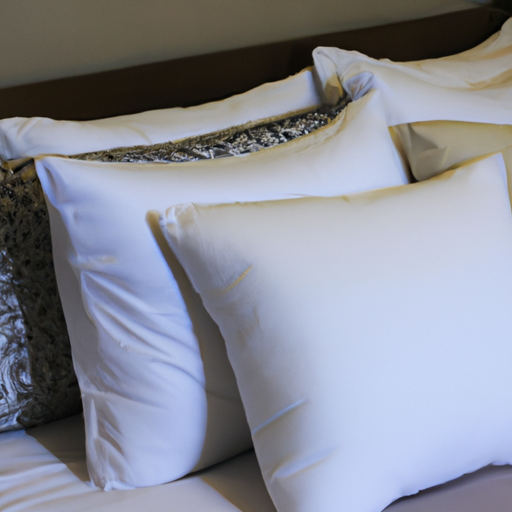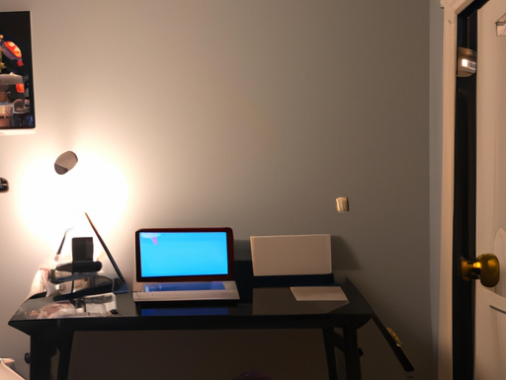-
Table of Contents
- Introduction
- How Many Pillows Should You Have on Your Bed?
- The Benefits of Having the Right Number of Pillows on Your Bed
- How to Choose the Right Number of Pillows for Your Bed
- How to Arrange Pillows on Your Bed for Maximum Comfort
- The Pros and Cons of Having Too Many Pillows on Your Bed
- How to Clean and Care for Your Pillows to Keep Them Looking and Feeling Great
- The Best Pillow Types for Different Sleepers and Bed Sizes
- Q&A
- Conclusion
Introduction
When it comes to decorating a bedroom, one of the most important elements is the bed. Not only does it provide a place to sleep, but it also serves as a focal point for the room. One of the key decisions when it comes to bedding is how many pillows should be on the bed. This can be a tricky question to answer, as there are many factors to consider. In this article, we will explore the different factors to consider when deciding how many pillows should be on a bed.
How Many Pillows Should You Have on Your Bed?
It is recommended that you have two to four pillows on your bed. The number of pillows you should have depends on your sleeping position and personal preference.
If you sleep on your back, two pillows are usually sufficient. A medium-firm pillow should be placed under your head and a softer pillow should be placed under your neck. This will provide the necessary support for your head and neck.
If you sleep on your side, you may need more pillows. A medium-firm pillow should be placed under your head and a softer pillow should be placed between your knees. This will help to keep your spine in alignment and reduce pressure on your hips and shoulders.
If you sleep on your stomach, you may need fewer pillows. A thin pillow should be placed under your head and a thin pillow should be placed under your stomach. This will help to keep your spine in alignment and reduce pressure on your neck and back.
In addition to the pillows you use for sleeping, you may also want to have decorative pillows on your bed. These can add a touch of style and comfort to your bedroom.
No matter how many pillows you choose to have on your bed, it is important to make sure they are comfortable and supportive. This will help you get a good night’s sleep and wake up feeling refreshed.
The Benefits of Having the Right Number of Pillows on Your Bed
Having the right number of pillows on your bed can provide a number of benefits. Pillows are an important part of a comfortable sleep environment, and having the right number of pillows can help ensure that you get a good night’s rest. Here are some of the benefits of having the right number of pillows on your bed.
First, having the right number of pillows can help provide the right amount of support for your head and neck. Too few pillows can leave your head and neck unsupported, leading to discomfort and poor sleep quality. Too many pillows can cause your head and neck to be propped up at an uncomfortable angle, leading to the same issues. Having the right number of pillows can help ensure that your head and neck are properly supported throughout the night.
Second, having the right number of pillows can help create a more aesthetically pleasing look for your bed. Too few pillows can make your bed look sparse and uninviting, while too many pillows can make it look cluttered and messy. Having the right number of pillows can help create a balanced and inviting look for your bed.
Finally, having the right number of pillows can help create a more comfortable sleeping environment. Too few pillows can leave you feeling exposed and vulnerable, while too many pillows can make it difficult to move around in bed. Having the right number of pillows can help create a cozy and comfortable sleeping environment.
In conclusion, having the right number of pillows on your bed can provide a number of benefits. It can help ensure that your head and neck are properly supported, create a more aesthetically pleasing look for your bed, and create a more comfortable sleeping environment. For these reasons, it is important to make sure that you have the right number of pillows on your bed.
How to Choose the Right Number of Pillows for Your Bed
When it comes to choosing the right number of pillows for your bed, there are a few factors to consider. First, consider the size of your bed. If you have a larger bed, such as a king or queen size, you may want to opt for more pillows. On the other hand, if you have a smaller bed, such as a twin or full size, you may want to opt for fewer pillows.
Next, consider the type of pillows you want to use. If you are looking for a more decorative look, you may want to opt for more pillows. However, if you are looking for a more comfortable sleeping experience, you may want to opt for fewer pillows.
Finally, consider the type of sleeper you are. If you are a side sleeper, you may want to opt for more pillows to provide extra support for your neck and shoulders. If you are a back sleeper, you may want to opt for fewer pillows to provide more space for your head and neck.
Ultimately, the number of pillows you choose for your bed is a personal preference. However, by considering the size of your bed, the type of pillows you want to use, and the type of sleeper you are, you can make an informed decision about the right number of pillows for your bed.
How to Arrange Pillows on Your Bed for Maximum Comfort
Creating a comfortable and inviting bed is an important part of creating a relaxing bedroom. Pillows are an essential part of this process, and arranging them correctly can make a big difference in the overall comfort of your bed. Here are some tips for arranging pillows on your bed for maximum comfort.
First, start with the basics. Place two standard-sized pillows at the head of the bed, one on each side. These should be placed so that the pillows are slightly propped up, allowing you to comfortably rest your head and neck.
Next, add a few decorative pillows. These can be placed in front of the two standard pillows, or on top of them. Choose pillows that are comfortable and inviting, such as down-filled pillows or those with a soft texture.
Finally, add a few accent pillows. These can be placed at the foot of the bed, or on the sides. Accent pillows can be used to add a pop of color or texture to the bed, and can also be used to provide extra support when sitting up in bed.
By following these tips, you can create a comfortable and inviting bed that is perfect for relaxing and getting a good night’s sleep. With the right combination of pillows, you can create a bed that is both comfortable and stylish.
The Pros and Cons of Having Too Many Pillows on Your Bed
Having too many pillows on your bed can be both beneficial and detrimental. On the one hand, having a large number of pillows can provide a great deal of comfort and support. Pillows can be used to prop up your head and neck, providing a comfortable sleeping position. They can also be used to cushion your body, making it easier to fall asleep. Additionally, having a variety of pillows can add a decorative touch to your bedroom.
On the other hand, having too many pillows on your bed can be problematic. Too many pillows can make it difficult to move around in bed, as they can take up a lot of space. Additionally, having too many pillows can make it difficult to make the bed in the morning, as they can be hard to arrange. Furthermore, having too many pillows can make it difficult to keep your bed clean, as they can trap dust and dirt.
In conclusion, having too many pillows on your bed can be both beneficial and detrimental. It is important to consider the pros and cons before deciding how many pillows to have on your bed.
How to Clean and Care for Your Pillows to Keep Them Looking and Feeling Great
Pillows are an essential part of a comfortable sleep experience. To ensure that your pillows remain in good condition and provide you with the best possible comfort, it is important to clean and care for them properly. Here are some tips to help you keep your pillows looking and feeling great.
First, it is important to wash your pillows regularly. Most pillows can be machine washed on a gentle cycle with warm water and a mild detergent. If your pillow is not machine washable, you can spot clean it with a mild detergent and warm water. Be sure to read the care instructions on the label before washing.
After washing, it is important to dry your pillows properly. Most pillows can be dried in the dryer on a low heat setting. If your pillow is not machine dryable, you can air dry it by laying it flat on a towel. Be sure to fluff the pillow periodically while it is drying to help it retain its shape.
It is also important to protect your pillows from dust and dirt. To do this, you can use a pillow protector or pillowcase. Pillow protectors are made of a waterproof material that helps keep your pillow clean and dry. Pillowcases are also a great way to keep your pillow clean and add a decorative touch to your bedding.
Finally, it is important to replace your pillows regularly. Most pillows should be replaced every two to three years. This will help ensure that your pillows remain comfortable and supportive.
By following these tips, you can keep your pillows looking and feeling great. With proper care and maintenance, your pillows will provide you with a comfortable and restful sleep experience for years to come.
The Best Pillow Types for Different Sleepers and Bed Sizes
When it comes to choosing the right pillow for a good night’s sleep, there are many factors to consider. Pillow type, size, and firmness all play a role in finding the perfect pillow for your individual needs. Here, we will discuss the best pillow types for different sleepers and bed sizes.
For side sleepers, a contoured pillow is the best option. This type of pillow is designed to provide support for the neck and head while keeping the spine in alignment. It is also beneficial for those who suffer from neck pain or shoulder pain.
For back sleepers, a medium-firm pillow is ideal. This type of pillow provides support for the neck and head while keeping the spine in alignment. It is also beneficial for those who suffer from lower back pain.
For stomach sleepers, a thin, flat pillow is the best option. This type of pillow is designed to provide minimal support for the neck and head while keeping the spine in alignment. It is also beneficial for those who suffer from neck pain or shoulder pain.
When it comes to bed size, the size of the pillow should match the size of the bed. For a twin-sized bed, a standard-sized pillow is best. For a full-sized bed, a queen-sized pillow is ideal. For a king-sized bed, a king-sized pillow is recommended.
In conclusion, the best pillow type for different sleepers and bed sizes depends on individual needs. Side sleepers should opt for a contoured pillow, back sleepers should choose a medium-firm pillow, and stomach sleepers should select a thin, flat pillow. Additionally, the size of the pillow should match the size of the bed. With the right pillow, you can enjoy a comfortable and restful night’s sleep.
Q&A
1. How many pillows should be on a bed?
The number of pillows on a bed depends on personal preference. Generally, two pillows are used for sleeping, while additional pillows can be used for decorative purposes.
2. What type of pillows should be used on a bed?
The type of pillows used on a bed should be based on personal preference. Generally, down or synthetic pillows are used for sleeping, while decorative pillows can be made of any material.
3. What size pillows should be used on a bed?
The size of pillows used on a bed should be based on personal preference. Generally, standard-sized pillows are used for sleeping, while decorative pillows can be any size.
4. How often should pillows be replaced?
Pillows should be replaced every 1-2 years, depending on how often they are used.
5. What is the best way to store pillows?
The best way to store pillows is in a cool, dry place. Pillows should also be stored in a breathable bag or container to prevent dust and moisture buildup.
6. How can pillows be cleaned?
Pillows can be cleaned by spot-cleaning with a mild detergent and warm water, or by machine-washing in cold water on a gentle cycle.
7. What is the best way to fluff pillows?
The best way to fluff pillows is to place them in the dryer on a low heat setting with a few clean tennis balls. This will help to restore the pillows’ shape and fluffiness.
Conclusion
In conclusion, the number of pillows on a bed is ultimately up to personal preference. Some people prefer to sleep with just one pillow, while others may prefer to sleep with multiple pillows. Ultimately, the number of pillows on a bed should be based on what is most comfortable for the individual.




